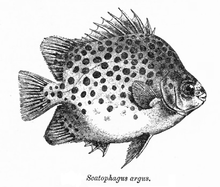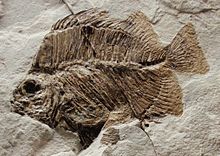| Scatophagus | |
|---|---|

| |
| (Scatophagus argus) | |
| Scientific classification | |
| Domain: | Eukaryota |
| Kingdom: | Animalia |
| Phylum: | Chordata |
| Class: | Actinopterygii |
| Order: | Acanthuriformes |
| Family: | Scatophagidae |
| Genus: | Scatophagus Cuvier in Cuvier and Valenciennes, 1831 |
| Type species | |
| Chaetodon argus Linnaeus, 1766 | |
| Species | |
|
See text | |
| Synonyms | |
Scatophagus is a genus of ray-finned fishes belonging to the family Scatophagidae. They are found in the Indo-Pacific region. Species in this genus are referred as spotted scats.
Taxonomy
Scatophagus was first formally described as a genus in 1831 by the French zoologist Georges Cuvier with Chaetodon argus which had been described from India by Linnaeus in 1766 later designated as the type species. The genus name is a compound of skatos meaning "dung" and phaga which means to eat, a reference to this species purported taste for human faeces.
Species
The genus Scatophagus contains two extant species:
- Scatophagus argus (Linnaeus, 1766) (Spotted scat)
- Scatophagus tetracanthus (Lacépède, 1802) (African scat)
Extinct species
The fossil Eoscatophagus frontalis Tyler & Sorbini, 1999 (syn. Scatophagus frontalis Agassiz, 1839) is from the Middle Eocene of the North Italian Monte Bolca formation that originated from sediments of the Tethys.


Characteristics
Scatophagus species have highly compressed, rectangular bodies. The dorsal profile of the head rises steeply to the nape, they have a rounded snout, as is the space between the eyes. The small mouth is horizontal, and cannot be protruded, and has several rows of small bristle like teeth on the jaws teeth in several rows. There are no teeth on the roof of the mouth. The dorsal fin has 11-12 robust spines and 16-18 soft rays, the first spine lies flat and there is a deep incision between the spiny and soft rayed parts of the fin. The anal fin has 4 robust spines and 13-16 soft rays and the relatively small pectoral fins have 16-17 rays. The caudal fin may be truncate or weakly emarginate. although it is rounded in juveniles. The head and the body are covered with tiny ctenoid scales and these reach the soft rayed parts of the dorsal and anal fins. There are no spines or serrations on the opercular bones. They are silvery or greenish in colour marked with darker spots or bars. The scats vary in maximum total length from 30 cm (12 in) for S. tetracanthus up to 38 cm (15 in) for S. argus.
Distribution and habitat
Scatophagus fishes are found in the Indo-Pacific from the coast of East Africa east into the western Pacific Ocean north to Japan, south to Australia and east to the Society Islands. One species, S.argus, has become an established introduced species off Malta and has been recorded occasionally off Florida. They are found in sheltered habitats in coastal areas, including in brackish water and even into freshwater rivers.
Biology
Scatophagus fishes feed on a diverse diet which includes small invertebrates, algae, detritus and refuse. They are venomous, a gland on the lateral line produces venom and a groove takes this onto the spines. If envenomated the wound is painful and may ache for a number of hours.
Utilisation
Scatophagus scats are caught using gill nets and traps and may be marketed fresh or salted. They feature in the live fish market in Hong Kong and are used in traditional Chinese medicine. They also appear in the aquarium trade.
See also
References
- ^ Eschmeyer, William N.; Fricke, Ron & van der Laan, Richard (eds.). "Genera in the family Scatophagidae". Catalog of Fishes. California Academy of Sciences. Retrieved 19 August 2021.
- Christopher Scharpf & Kenneth J. Lazara, eds. (12 January 2021). "Order Acanthuriformes (part 2): Families Ephippidae, Leiognathidae, Scatophagidae, Antigoniidae, Siganidae, Caproidae, Luvaridae, Zanclidae and Acanthuridae". The ETYFish Project Fish Name Etymology Database. Christopher Scharpf and Kenneth J. Lazara. Retrieved 17 August 2021.
- ^ Froese, Rainer; Pauly, Daniel (eds.). "Species in genus Scatophagus". FishBase. June 2021 version.
- Tyler, J.C. & Sorbini, C. 1999. Phylogeny of the fossil and recent genera of fishes of the family Scatophagidae (Squamipinnes). Boll. Mus. Civ. Stor. Nat. Verona 23
- pages 353–393
- L. Agassiz. 1842. Recherches Sur Les Poissons Fossiles. Tome IV (livr. 14). Imprimerie de Petitpierre, Neuchâtel 205-291 (French)
- Karl Albert Frickhinger: Fossilien Atlas Fische, Mergus-Verlag, Melle, 1999, ISBN 3-88244-018-X
- ^ "Scatophagidae" (PDF). FAO Species Identification Sheets. FAO. Retrieved 18 August 2021.
- ^ Schofield, P.J. (2021). "Scatophagus argus (Linnaeus, 1766)". Nonindigenous Aquatic Species Database, Gainesville, FL. U.S. Geological Survey. Retrieved 18 August 2021.
- "Scatophagus argus". Tropical Fish Hobbyist Magazine. April 2004. Retrieved 18 August 2021.
External links
- "Scatophagus". Integrated Taxonomic Information System. Retrieved 23 August 2015.
- [REDACTED] Data related to Scatophagus at Wikispecies
- Parenti, Paolo (February 2004). "Family Scatophagidae Bleeker 1876" (PDF). Annotated Checklists of Fishes (36). ISSN 1545-150X.
| Taxon identifiers | |
|---|---|
| Scatophagus | |